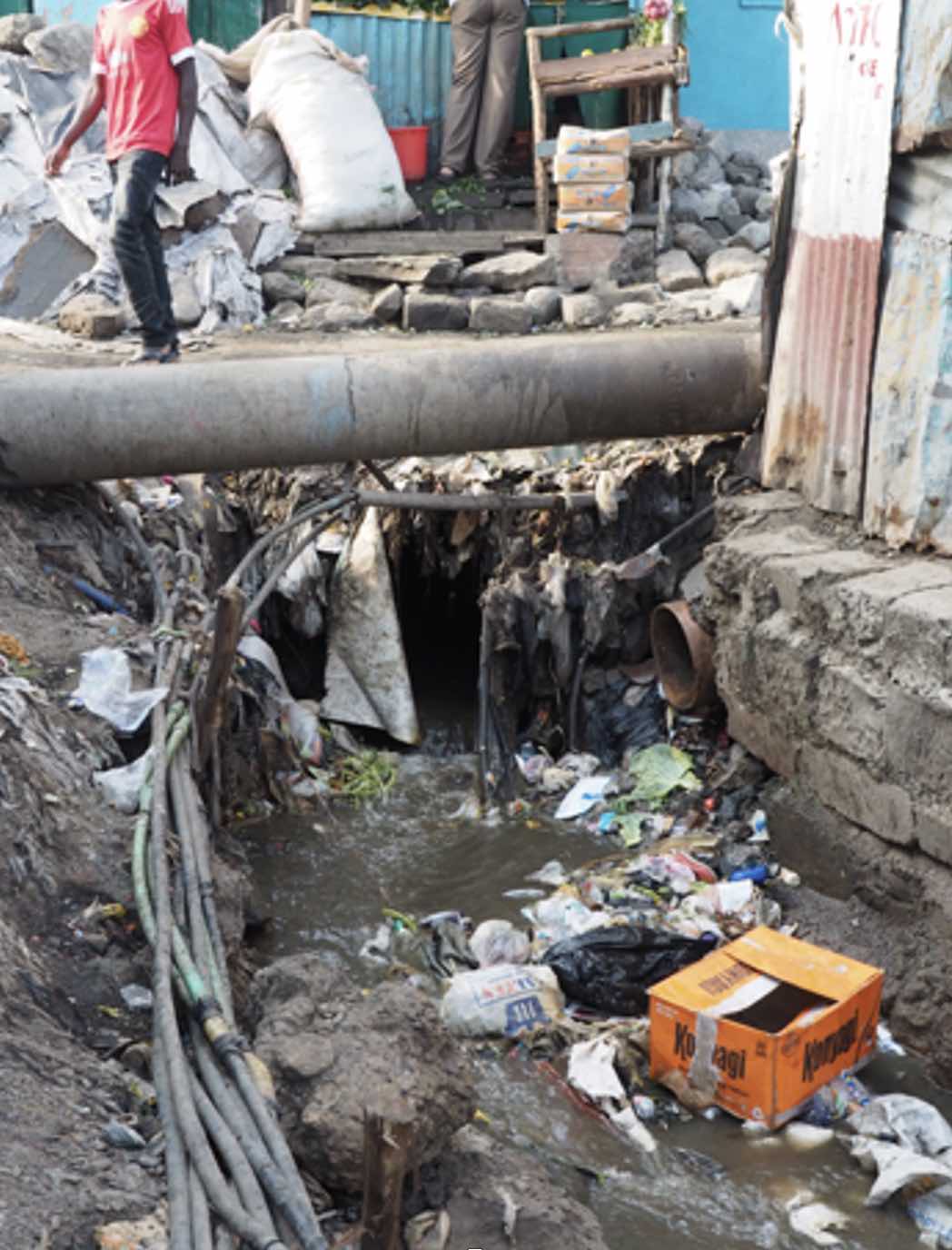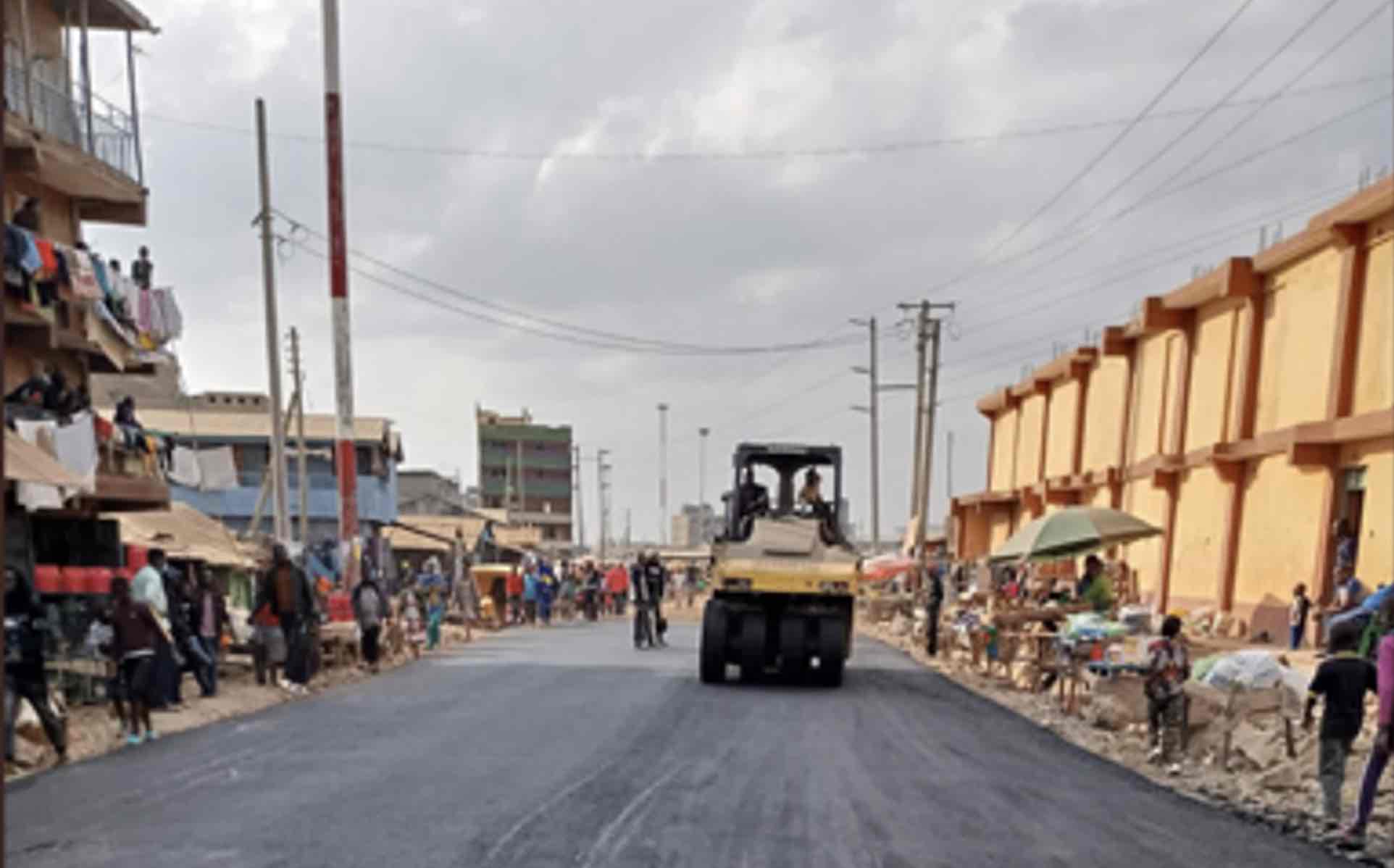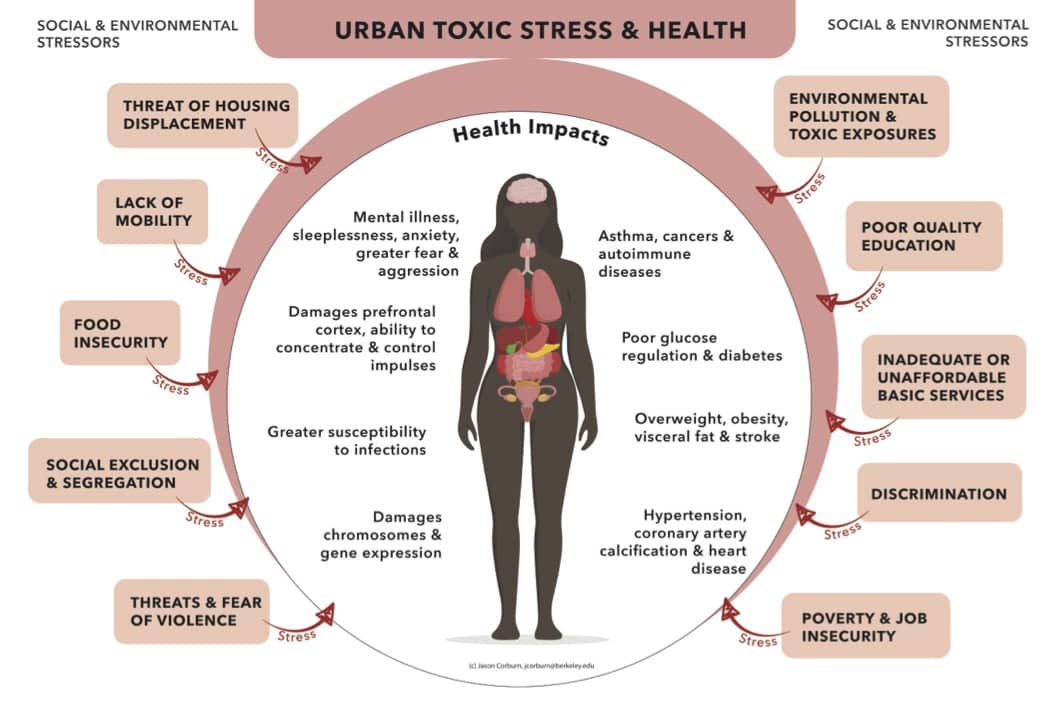
www.buildingsandcities.org/insights/commentaries/cop26-healing-cities.html
Healing Cities: Toward Urban Climate Justice & Slum Health
By Jason Corburn (University of California, Berkeley, US)
The overlapping crises of climate change, COVID-19, and persistent social inequities are acutely felt in cities, particularly among the poor and already vulnerable. Urban climate justice demands a focused strategy to support the healing of these vulnerable communities while also creating new opportunities for them to co-lead more equitable climate resiliency strategies. COP-26 must address 'healing cities for climate justice;' or the need for urgent investments with (not on or for) already vulnerable people and places in order to eliminate existing suffering and urban traumas, while also planning for future prosperity.
What might a healing city for climate justice strategy look like in practice? We suggest this approach is critical for planetary well-being and the survival of the approximately one billion people living in self-built, informal settlements, often called slums (UN 2019). A healing cities for urban climate justice strategy can also move us closer to Sustainable Development Goals 1, 3, 5, 6, 10, 11 and 13, among others (Corburn & Sverdlik 2017).

Consider: Nairobi, Kenya, a city of just under 5 million where about 65% live in self-built, informal settlements that lack access to basic, life-supporting infrastructure and services (Figure 1). In one slum called Mukuru, community-driven research was conducted by residents in partnership with local and international NGOs and universities (Corburn et al. 2019) which led to the community being designated a Special Planning Area (SPA) (Muungano Alliance 2021). This designation ensured a new redevelopment plan would be drafted with resident input and expertise, and that the improvement plan must address the multiple traumas afflicting Nairobi's slum dwellers, including: climate change risks from flooding and disease, social and physical exclusion, lack of water, sanitation and energy infrastructure, secure tenure and environmental injustices from toxic dumping and localized air pollution (Horn 2021). The county government was also involved, as were national governmental institutions. Findings were shared with tens of Mukuru SPA 'consortium' partners and, with resident input, turned into an integrated upgrading plan. The improvement strategies included prioritizing the needs of the most vulnerable, such as reducing flooding risks for the poorest of the poor living along river riparian areas, delivering water and safe sanitation to women, and creating new public spaces for youth to play, create and learn (Anderson 2014).
When
COVID-19 emerged in 2020, the Nairobi Metropolitan Services (NMS) was empowered
by the Kenyan government to lead the response in many informal
settlements. Mukuru was one of the first
places selected for investments, in part because residents were already mobilized,
had already developed a plan and many built environment projects were 'shovel
ready' (Weru & Cobbett 2021).
Instead of just getting temporary services and treatment, which would
have been typical during an emergency response, Mukuru received permanent,
healing-focused, life-supporting built environment investments. Kilometers of
roads, sidewalks and bicycle paths were tarmacked, connecting previously
disconnected villages within the community and linking the entire settlement to
services, jobs, schools, and the benefits of the entire city (Figure 2). 
The Mukuru projects are promoting healing and urban climate justice by reducing vulnerability today while building the physical, social and governance infrastructure for resident prosperity moving forward (Sverdlik et al. 2019). While incomplete and an on-going project, Mukuru's transformation reflects the values of how a city can invest in its least-well-off places and populations first, while delivering benefits to everyone (Ng'ang'a 2021).

As COP-26 considers strategies to reduce planetary suffering, the lessons from Mukuru must inform urban design and planning practice. First, practitioners must work with the poor and vulnerable communities to identify the toxic stressors (Figure 3) - or those inequalities contributing to suffering, trauma and disease - not rely on professional 'experts' alone (Corburn 2017). Next, residents, civil society groups, universities, and local governments must co-create actionable plans to support healing, which means focusing design and investments on reducing trauma and stress through a combination of physical infrastructure, social programs and democratic decision-making (Ellis & Dietz 2017). Third, professionals must practice humility and learn-by-doing with local people, not acting for or 'on' them. Finally, cities that heal and promote climate justice must adapt as they learn what is and is not supporting the well-being of the poor and marginalized communities. A one size fits all approach will not heal those suffering today, and will not contribute to prosperity for all moving forward.
References
ABC News. (2021). Vending machines bring safe, cheap water to Nairobi slums. https://www.abc.net.au/news/2021-09-18/kenya-water-vending-machines-mukuru-slums/100465320
All Africa. (2021). Kenyatta commissions five new hospitals in Nairobi. https://allafrica.com/stories/202107070114.html
Anderson, M. (2014). Nairobi's female slum dwellers march for sanitation and land rights. The Guardian. https://www.theguardian.com/global-development/2014/oct/29/nairobi-slum-dwellers-sanitation-land-rights
Corburn, J. (2017). Urban place and health equity: critical issues and practices. International Journal of Environmental Research and Public Health, 14(2), 117. doi: 10.3390/ijerph14020117
Corburn, J., Asari, M.R., Wagner, A., Omolo, T. Chung, B., Cutler, C. Nuru, S., Ogutu, B., Lebu, S. & Atukunda, L. (2019). Mukuru Special Planning Area: Rapid Health Impact Assessment. Berkeley: Center for Global Healthy Cities. https://static1.squarespace.com/static/591a33ba9de4bb62555cc445/t/5e6d77579988a61549be14a8/1584232291593/Mukuru+Nairobi+Health+Impact+Assessment+2019_UCB.pdf
Corburn, J. & Sverdlik, A. (2017). Slum upgrading and health equity. International Journal of Environmental Research and Public Health, 14(4): 342. doi: 10.3390/ijerph14040342
Ellis, W.R., Dietz, W.H. (2017). A new framework for addressing adverse childhood and community experiences: the building community resilience model. Academic Pediatrics,17(7S):S86-S93. doi: 10.1016/j.acap.2016.12.011
Horn, P. (2021). Enabling participatory planning to be scaled in exclusionary urban political environments: lessons from the Mukuru Special Planning Area in Nairobi. Environment and Urbanization. doi:10.1177/09562478211011088
Kinyanjui, M. (2021). NMS projects slowly changing the face of Mukuru slums. The Star. https://www.the-star.co.ke/news/2021-08-16-nms-projects-slowly-changing-the-face-of-mukuru-slums/
Muungano Alliance (2021) Mukuru SPA. https://www.muungano.net/mukuru-spa
Ng'ang'a, J. (2021). Projects to upgrade informal settlements on top gear. Kenya News Agency. https://www.kenyanews.go.ke/projects-to-upgrade-informal-settlements-on-top-gear/
Sverdlik, A., Mitlin, D. & Dodman, D. (2019). Realising the Multiple Benefits of Climate Resilience and Inclusive Development in Informal Settlements. New York: C40 Cities Climate Leadership Group. https://reliefweb.int/sites/reliefweb.int/files/resources/C40-Climate-Resilience-Inclusive-Housing.pdf
United Nations. (2019). SDGs progress report: Goal 11. https://unstats.un.org/sdgs/report/2019/goal-11/
Weru, J. & Cobbett, W. (2021). Slum upgrading in Kenya: what are the conditions for success? Thomson Reuters News Foundation. https://news.trust.org/item/20210225133836-td97u
Latest Peer-Reviewed Journal Content
A framework for 1.5°C-aligned GHG budgets in architecture
G Betti, I Spaar, D Bachmann, A Jerosch-Herold, E Kühner, R Yang, K Avhad & S Sinning
Net zero retrofit of the building stock [editorial]
D Godoy-Shimizu & P Steadman
Co-learning in living labs: nurturing civic agency and resilience
A Belfield
The importance of multi-roles and code-switching in living labs
H Noller & A Tarik
Researchers’ shifting roles in living labs for knowledge co-production
C-C Dobre & G Faldi
Increasing civic resilience in urban living labs: city authorities’ roles
E Alatalo, M Laine & M Kyrönviita
Co-curation as civic practice in community engagement
Z Li, M Sunikka-Blank, R Purohit & F Samuel
Preserving buildings: emission reductions from circular economy strategies in Austria
N Alaux, V Kulmer, J Vogel & A Passer
Urban living labs: relationality between institutions and local circularity
P Palo, M Adelfio, J Lundin & E Brandão
Living labs: epistemic modelling, temporariness and land value
J Clossick, T Khonsari & U Steven
Co-creating interventions to prevent mosquito-borne disease transmission in hospitals
O Sloan Wood, E Lupenza, D M Agnello, J B Knudsen, M Msellem, K L Schiøler & F Saleh
Circularity at the neighbourhood scale: co-creative living lab lessons
J Honsa, A Versele, T Van de Kerckhove & C Piccardo
Positive energy districts and energy communities: how living labs create value
E Malakhatka, O Shafqat, A Sandoff & L Thuvander
Built environment governance and professionalism: the end of laissez-faire (again)
S Foxell
Co-creating justice in housing energy transitions through energy living labs
D Ricci, C Leiwakabessy, S van Wieringen, P de Koning & T Konstantinou
HVAC characterisation of existing Canadian buildings for decarbonisation retrofit identification
J Adebisi & J J McArthur
Simulation and the building performance gap [editorial]
M Donn
Developing criteria for effective building-sector commitments in nationally determined contributions
P Graham, K McFarlane & M Taheri
Reimagining circularity: actions for optimising the use of existing buildings
R Lundgren, R Kyrö, S Toivonen & L Tähtinen
Effective interdisciplinary stakeholder engagement in net zero building design
S Vakeva-Baird, F Tahmasebi, JJ Williams & D Mumovic
Metrics for building component disassembly potential: a practical framework
H Järvelä, A Lehto, T Pirilä & M Kuittinen
The unfitness of dwellings: why spatial and conceptual boundaries matter
E Nisonen, D Milián Bernal & S Pelsmakers
Environmental variables and air quality: implications for planning and public health
H Itzhak-Ben-Shalom, T Saroglou, V Multanen, A Vanunu, A Karnieli, D Katoshevski, N Davidovitch & I A Meir
Exploring diverse drivers behind hybrid heating solutions
S Kilpeläinen, S Pelsmakers, R Castaño-Rosa & M-S Miettinen
Urban rooms and the expanded ecology of urban living labs
E Akbil & C Butterworth
Living with extreme heat: perceptions and experiences
L King & C Demski
A systemic decision-making model for energy retrofits
C Schünemann, M Dshemuchadse & S Scherbaum
Modelling site-specific outdoor temperature for buildings in urban environments
K Cebrat, J Narożny, M Baborska-Narożny & M Smektała
Understanding shading through home-use experience, measurement and modelling
M Baborska-Narożny, K Bandurski, & M Grudzińska
Building performance simulation for sensemaking in architectural pedagogy
M Bohm
Beyond the building: governance challenges in social housing retrofit
H Charles
Heat stress in social housing districts: tree cover–built form interaction
C Lopez-Ordoñez, E Garcia-Nevado, H Coch & M Morganti
An observational analysis of shade-related pedestrian activity
M Levenson, D Pearlmutter & O Aleksandrowicz
Learning to sail a building: a people-first approach to retrofit
B Bordass, R Pender, K Steele & A Graham
Market transformations: gas conversion as a blueprint for net zero retrofit
A Gillich
Resistance against zero-emission neighbourhood infrastructuring: key lessons from Norway
T Berker & R Woods
Megatrends and weak signals shaping future real estate
S Toivonen
A strategic niche management framework to scale deep energy retrofits
T H King & M Jemtrud
Generative AI: reconfiguring supervision and doctoral research
P Boyd & D Harding
Exploring interactions between shading and view using visual difference prediction
S Wasilewski & M Andersen
How urban green infrastructure contributes to carbon neutrality [briefing note]
R Hautamäki, L Kulmala, M Ariluoma & L Järvi
Implementing and operating net zero buildings in South Africa
R Terblanche, C May & J Steward
Quantifying inter-dwelling air exchanges during fan pressurisation tests
D Glew, F Thomas, D Miles-Shenton & J Parker
Western Asian and Northern African residential building stocks: archetype analysis
S Akin, A Eghbali, C Nwagwu & E Hertwich
Join Our Community

The most important part of any journal is our people – readers, authors, reviewers, editorial board members and editors. You are cordially invited to join our community by joining our mailing list. We send out occasional emails about the journal – calls for papers, special issues, events and more.
We will not share your email with third parties. Read more



Latest Commentaries
COP30 Report
Matti Kuittinen (Aalto University) reflects on his experience of attending the 2025 UN Conference of the Parties in Belém, Brazil. The roadmaps and commitments failed to deliver the objectives of the 2025 Paris Agreement. However, 2 countries - Japan and Senegal - announced they are creating roadmaps to decarbonise their buildings. An international group of government ministers put housing on the agenda - specifying the need for reduced carbon and energy use along with affordability, quality and climate resilience.
Building-Related Research: New Context, New Challenges
Raymond J. Cole (University of British Columbia) reflects on the key challenges raised in the 34 commissioned essays for Buildings & Cities 5th anniversary. Not only are key research issues identified, but the consequences of changing contexts for conducting research and tailoring its influence on society are highlighted as key areas of action.